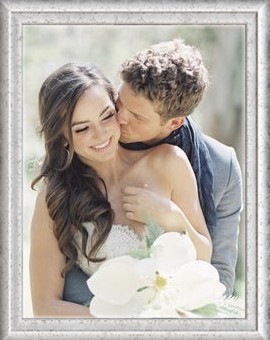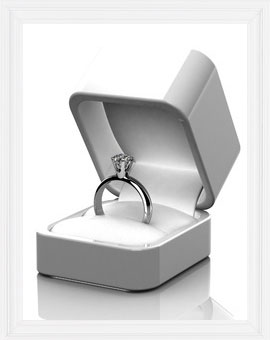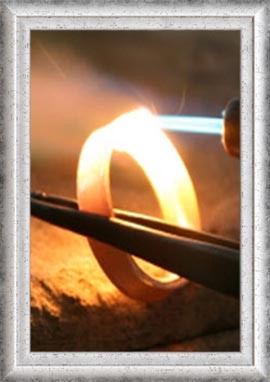Diamond Shapes
|
|
By far the most preferred diamond shape, the round-brilliant cut is also the most optically brilliant because of its 360-degree symmetrical shape. A round brilliant is a great choice if you want the most sparkle and the most enduring classic shape. The round shape has been cut for centuries, but in 1919, Marcel Tolkowsky defined specific angles and proportions to yield the most brilliant diamond, which form the basis for the modern "Ideal" cut round-brilliant diamond. Round-brilliant diamonds are the only shape to have this ideal proportion defined. The round silhouette works with almost every mounting, from classic solitaires to the most avant-garde designs. Rounds can be set into four or six prongs, based on the design of the setting, or into bezel mountings (a metal band that runs around the edge of the diamond to hold it securely in the setting). In general, if the round brilliant has an Ideal cut or Very Good cut, you want the setting to have the least amount of metal around the stone so that it is held securely but does not cover up too much of the diamond and block light from entering the stone. |
|
|
The marquise cut is a regal, elongated shape with tapering points at both ends. Its shape tends to flatter the finger, making it appear longer. When choosing a marquise cut, the length-to-width ratio should be considered. Usually a ratio of 2:1.0 is preferred, meaning that the length of the stone should be about 2 times the width of the diamond. However, like all fancy shapes, personal preference prevails, and some may prefer a shorter, wider outline or longer, thinner shape. Just look for good symmetry to ensure overall beauty no matter what outline you prefer. This shape works in a simple solitaire setting or looks beautiful with side stones, especially baguette or trillion shapes. A marquise-cut diamond should be mounted with six prongs: four positioned on the sides to hold the body of the stone securely and two V-shaped prongs to protect the points at either end, the most vulnerable part of the diamond. |
|
|
The princess cut is a modern classic of clean, square lines and beautiful sparkle. This shape is the perfect choice if you prefer a square or rectangular outline but want the brilliance of a round. Developed in the 1970s, the princess cut is now second only to the round brilliant in popularity. The cutting of this diamond combines the step-cutting of the emerald cut with the triangular facets of the brilliant cut and is cut with right-angle corners. Although most prefer a square outline, some stones are cut with a slightly more rectangular outline. The princess cut works beautifully as a solitaire but also looks great paired with side stones, especially trillions or smaller princess-cut diamonds. It is important to protect the more vulnerable corners with a V-shaped prong at each point. |
|
|
The emerald-cut diamond is among the most classic of diamond shapes. Its clean lines come from step-cutting, or parallel line facets. It is always cut with blocked corners and is usually cut to a rectangular outline, although a few are cut to be more square. Because of its simpler faceting structure, larger inclusions are sometimes more visible to the unaided eye, so diamonds cut in this shape usually need to be higher clarity (I1 or I2 clarities should probably be avoided). Length-to-width ratios should be considered when choosing an emerald cut: Usually a 1.50:1.00 ratio is preferred, meaning that the length of the stone should be about 1½ times the width of the diamond. However, like all fancy shapes, personal preference prevails, and some may prefer a squarer outline, or longer, thinner rectangle. An emerald cut is loved by purists and looks especially wonderful set in platinum, in a simple setting or a baguette side-stone setting. |
|
|
The oval cut is most similar a round-brilliant cut and combines the round's sparkle with a flattering, elongated outline. It makes a good choice for someone who wants a unique shape but loves the fire and brilliance of a round diamond. The length-to-width ratio of ovals can vary based on personal preference. Generally a ratio of 1.5:1.0 is preferred, meaning that the length of the stone should be about 1½ times the width of the diamond. However, like all fancy shapes, personal choice should guide you; some may prefer a shorter, wider outline or a longer, thinner shape. The relatively symmetrical shape lends itself well to a variety of mounting styles. Most oval cuts look great in any mounting meant for a round brilliant as long as the setting that holds the diamond has six prongs properly spaced for security. |
|
|
Baguettes have unbeveled corners and usually only two rows of facets.They may be rectangular or tapered. Like the emerald cut, the baguette does not have the sparkle of a brilliant cut but has a classic beauty. Higher color and clarity are important for the Baguette cut diamond because there are not facets to hide inclusions or body color. |
|
|
The heart-shaped diamond is the most romantic of diamond shapes. It is similar to the pear shape but has a cleft in the rounded end that forms the lobes of the heart. The complexity of the shape requires skilled cutting to ensure proper brilliance. Symmetry is a big consideration for this shape, as the outline needs to have a pleasing, obvious heart outline apparent in the setting. The lobes should be rounded (not pointed) and clearly defined. Heart-shaped diamonds should be mounted in special settings with five prongs: two at the lobes of the heart, two on the sides of the heart, and a V-shaped prong to protect the point of the heart, the most vulnerable place on the diamond. |












